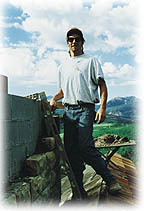 The "blue-collar thing"
The "blue-collar thing"Wythes Committee recommends 10-percent enrollment increase
by Royce Flippin '80
After holding its undergraduate population growth to barely 5 percent over the past 25 years, Old Nassau is about to experience its most significant upsizing since the introduction of coeducation in the late 1960s: a proposed 10-percent expansion of the undergraduate student body, from the current 4,600 to 5,100. The increase would be phased in over a four-year period beginning three or four years from now, once additional housing has been constructed.
This proposal became public in late January with the release of the Wythes Report, named after alumni trustee Paul M. Wythes '55, who chaired the committee that produced it. Formed to chart Princeton's course over the first decade of the 21st century, the Wythes Committee met 25 times over the past two and a half years, and its findings have been echoed by a separate Faculty Study Group on Undergraduate Admission. The next step will be to gather feedback on the committee's suggestions from alumni and other interested parties, before the entire Board of Trustees votes on the report in April.
"When we started this process, the committee was not totally convinced that raising enrollment was the way to go," recalls Paul Wythes. "But it quickly became clear that the issue of undergraduate class size had an overarching impact on every other issue we were looking at-the physical plant, the size of the graduate school, and so on. By the time we voted on the final recommendation, our committee approved it unanimously."
Why the 10 percent figure? "We sort of eased into it," says Wythes. "We wanted an increase that would be significant, but that was still relatively small." According to Wythes and others involved in the report's preparation, the proposed expansion was inspired by a number of converging factors, which can be summarized as follows.
Committee Arguments for a larger Princeton
Everything about Princeton has been getting bigger except the undergraduate student body. One concern of the Wythes Committee was that undergraduates, odd as it may sound, were becoming outnumbered on campus. While the undergraduate population has inched up by about two hundred (the aforementioned 5 percent) over the past 25 years, the size of the faculty has grown approximately 1 percent a year during that time-a rise driven largely by growth in academic disciplines such as creative writing, molecular biology, and computer science. As a result, the student-faculty ratio has dropped to about 6 to 1 from the 7 to 1 ratio that Princeton has traditionally striven for. In addition, the faculty is expected to grow another 10 percent over the next decade-essentially matching the undergraduate expansion. The bottom line is that 500 new students could be admitted without hiring any extra professors, while maintaining a 7 to 1 student-teacher ratio and continuing to limit precept size to 12 students or less. In fact, the larger student body may prove essential for certain growing departments such as microbiology and finance.
During that same period the number of graduate students (now about 1,800) rose 22 percent, and the university's administrative and support staff increased from about 1,950 full-time positions in 1980 to its current size of about 2,300 employees. The space devoted to classrooms, study areas, and recreational facilities has gone up as well.
The university has never been on sounder financial footing. As of July 1, 1999, Princeton's endowment stood at a record $6.5 billion, giving it the largest per-student endowment of any research university in the nation. "We have a world-class undergraduate experience going at Princeton, but we can't be an island," observes Wythes. "With the endowment so high, and with the tremendous educational resources we have, we had to ask ourselves whether we had a moral obligation to make those resources available to more students."
The quality and quantity of applicants to Princeton has reached near-staggering proportions. While the job of selecting students for admission to Princeton has never been easy, lately it's become next to impossible. Only 12 percent of applicants now get into the school, compared to a 40-percent admissions rate back in the 1950s. Dean of Admission Fred Hargadon has been saying for some time that he could easily admit an entire second freshman class each year, with no noticeable decline in student quality.
While adding an extra 125 students per class won't solve all of Hargadon's problems, it will ease them a bit. The expansion will also allow the university to add students in a few categories that are currently getting shorted. Among other things, says Wythes, more overseas applicants and sophomore-year transfer students are likely to be admitted. (The one group that definitely won't increase is the number of recruited athletes. Reason: The number of sports teams hasn't grown in recent decades.)
Increasing class size will allow more alumni children to be admitted. When Princeton went coed 30 years ago, class sizes quickly jumped a whopping 40 percent. Today, the children of these expanded alumni classes are reaching college age. The mathematical implications are clear: If legacy admissions hold steady as a percentage of total admissions (currently 12 percent), more alumni offspring will have to be admitted.
A 10-percent increase still leaves Princeton smaller than Harvard and Yale. The extra 125 students per year would swell Tiger class sizes to 1,275, still shy of the Elis (1,350 per class) and the Crimson (1,650 per class, the same size as Stanford).
Adding 500 more students won't require sacrificing resources in other areas. "Some people have said to me, 'Shouldn't we take care of other needs first?' " says Provost Jeremiah P. Ostriker. "In fact, this increase will pay for itself, in revenues from student tuition and fees. We'll need to add 10 percent more dorm space and purchase 10 percent more food-beyond that, however, the vast majority of our facilities won't have to be expanded."
According to the report, a new dormitory and a sixth residential college are the only new buildings envisioned at this point. Some kind of new dorm space was scheduled to be built anyway as a second "swing dorm" (along with the Scully dormitory), allowing the current dorm renovation program to be accelerated. Adding a sixth residential college (containing living and eating areas) has its own advantages, since it will enable the other five colleges to scale down their size slightly, from 500 students to 450 or so.
Alumni worry: quantity, not Princeton quality?
Doubts remain, however. An editorial in The Daily Princetonian, while cautiously endorsing an increase, voiced student concerns that popular classes will become even more crowded, and that precept sizes will suffer.
Alumni have their own questions. One is, how will this latest enrollment increase affect that ephemeral thing known as "the Princeton experience"? The other, corollary question: Where will it all end?
Some of these concerns have been batted back and forth recently on Princeton Matters, an online chat group for alumni. Terry Wintroub '69 is a leading critic of the new plan. "I'm worried that Princeton, as it gets bigger, is losing the very quality that has always made it special," says Wintroub. "When I was in school, the Princeton ideal was to be as intimate as, say, Antioch College, while also being a high-powered research university on a par with Harvard or Yale. Even then, it was hard to know everyone in your class. As it gets larger, Princeton is on the verge of becoming just another prestigious university. At that point, I begin to question whether there's anything unique any longer about the school, other than the fact that it happens to be located in the town of Princeton."
In fact, much of Princeton's growth has been dictated by history. Over the last century, the school has transformed itself from a socially rarefied, all-male campus of 1,000 to a diverse community of more than 6,000 undergraduate and graduate students; this latest proposal is yet another acknowledgment of the growing size and diversity of today's college-bound population. But how far should growth go? Is there an upper limit to how big Princeton can or should be?
The Wythes Committee tipped its hat to this knotty issue, but had no answer. "In the end," the report concludes, "it was not possible to determine with precision how many students at Princeton would be 'too many,' just as it was not possible when over a thousand students were added in connection with coeducation. Clearly the answer can change over time and may be different for different individuals."
At this point in time, the only certainty is that the university plans to hold the line at 5,000-plus for quite a while. "This is not something that's going happen frequently, and certainly not for another few decades," says Ostriker. "I'd be astounded if a similar proposal was brought to the Board of Trustees over the next 25 years."
Meanwhile, an architect has been hired to begin scouting locations for an additional dorm and residential college. The down-campus side of Dillon Gym and the fringes of Forbes College (formerly the Princeton Inn) have been mentioned as candidates for dorm sites, while the most likely setting for the new college is the field to the south of Butler College (originally New New Quad). The new building would form part of an elliptical structure, flanked on one side by the new Institute for Integrative Genomics soon to rise along Washington Road.
Richard R. Spies *72, vice president for finance and administration, points out that this "southern ellipse" could be a partial answer to the question of where Princeton's ultimate destiny lies. "The new structure would, for the first time, create a southern boundary for the university," says Spies. "We'll be drawing a line, and saying we won't build any dorms south of this point. In that sense, it represents one more piece of the final puzzle."
Royce Flippin is a freelance writer living in New York City.
Alumni trade Briefcases, suits for Jeans and saws
by Kathryn Federici Greenwood
After graduation, Sean Purcell '86 did his best to fit the Princeton stereotype. He tried insurance and real estate, became a stockbroker, then an options trader. But after a couple of years trading options on the floor of the Chicago Board of Options Exchange, he realized something about himself. "I still wasn't happy," he says. "No one makes enough money to justify the stress. I realized that I needed something more creative, with the freedom of ownership and that sense of pride that only comes with making something that will stand as a testament to your craftsmanship." Today, Purcell owns a construction company in Chicago that specializes in rehabbing houses and doing custom woodwork.
Gary Peniston '70 earned a degree in geology at Princeton and decided that he was going to become a practicing geologist. But after a few years of work he discovered he had a dangerous reaction to offices-they caused him to fall asleep. So he took up construction, starting out as a laborer. These days, Peniston is the sole employee of Gary Peniston Construction, based in Gig Harbor, Washington. "I wear the tool belt, climb ladders and haul Sheetrock, snake wires into crawl spaces that Indiana Jones wouldn't go into, mix concrete, calm down panicky homeowners, and on occasion curse my rotten luck at hitting a hidden live waterline with a Sheetrock nail."
Contrary to public perception, not every Princeton graduate is sluiced
onto Wall Street or into graduate school. Some alumni have deliberately
set aside white collars to become carpenters, plumbers, masons, and contractors
-and they have the callused hands, achy knees, and tanned and toned bodies
to show it. Their unconventional stories are proof that working with your
hands can be as rewarding as any of the more typical careers Princetonians
choose after graduation.
 The "blue-collar thing"
The "blue-collar thing"
Making mud, making money
The allure of being a ski bum took james (tate) rogers '90, who majored in anthropology, to the resort town of Telluride, Colorado. Rogers soon picked up masonry, because "that's what paid the best," and he quickly realized he had a talent for laying rock. He started at the bottom, mixing cement-masons call it "making mud"-but by the end of the first week on the job he was laying more rock than any of the other workers. Rogers, who grew up in Nashville, Tennessee, and has a slow, Southern drawl, eventually settled in Ridgway, Colorado, and started his own company, Rogers Masonry.
Most of his jobs, however, remain in Telluride. Rogers works on one house at a time, completing about five houses a year. He specializes in stone exteriors, fireplaces, and chimneys. He turns away business because he insists on working alongside his crew laying stone and overseeing each project from start to finish to make sure it's done right. "I enjoy the blue-collar thing . . . looking at what I've done at the end of a day," he says. "Seeing a big bunch of rock up there on the wall that's never going to come down as long as I'm alive."
Even so, laying stone for a living is "a tough dollar," says Rogers, who is married to an artist and has a four-year-old daughter. For the first several years of his business, he had to work seven days a week to underbid other masons. Years of chiseling, hammering, and lifting have left a toll on his body. He suffers from arthritis and back pain, and virtually every day he gets bloody knuckles. Sometimes when he hits rock with the chisel, pieces of steel fly off the tool, embedding themselves in his chest and arms. "It's like you got shot with a bullet," he says. "But you gotta keep working."
Going to Princeton has helped Rogers's business. "Most of the masons didn't even graduate from high school," he says, "so when [clients] run into one that went to Princeton, they're pretty impressed." As for his crew, "they don't even know what Ivy League is."
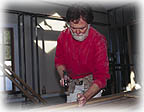 From Princeton to Trenton
From Princeton to Trenton
Sacrificing income to join a fight
After graduating from princeton with a degree in architecture, John Kemp '72 moved down Route 1 to Trenton, where he has gutted and rehabbed about six townhouses in the historic Mill Hill section and renovated storefronts, churches, and a Christian Science reading room. Most Princetonians avoid Trenton more consciously than New Haven, but Kemp wanted to "join a fight. Trenton had hit the skids in the '60s. [The city] was abandoned, in a sense, by society." Although by working in Trenton Kemp has sacrificed a lot of money, he says, "money was never really a factor. It seemed like the moral thing to do."
Kemp, a rugged man with a thick gray beard and reddish-brown hair, can see through debris and dust and imagine what can be. In the late 1980s he worked on a three-story, ramshackle townhouse in Mill Hill. The owner had bought the house, which had been foreclosed by the city, for $6,000 at an auction. Kemp gutted each floor, rebuilt the framework, and remodeled the entire house-including adding ornamental rosettes in the cornice of the building's facade. He also renovated another house two doors down the street, helping to turn what had been "a nasty piece of town" into a "pretty and thriving" corner, says Kemp, whose company is called Small Potatoes Construction.
Recently, however, Kemp has shied away from working in Trenton because of the bureaucracy involved in dealing with city planners. He still works on smaller projects in the city, but he also seeks other projects in the area. Last summer, he renovated an 1840s house in nearby Frenchtown, New Jersey.
Kemp's work away from work also involves houses. He builds one-of-a-kind furniture in a shop he shares with a furniture maker in Crosswicks, New Jersey. As jazz, classical music, or opera plays in the background, Kemp, who sings in classical concerts and performs in operas and stage shows, creates everything from end tables to bedroom shoji screens. "I'm definitely a hands-on guy," he says.
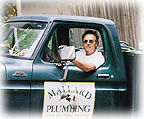 Academia dropout
Academia dropout
Historian turns plumber, takes on wily adversary
Like most people, robson tyrer '65 grew up taking plumbing for granted. The son of physicians, he majored in history at Princeton, earned a Ph.D. in the subject at the University of California at Berkeley, and taught Mexican history at San Francisco State. But Tyrer gradually became "disgusted" with academia. In the mid-1970s, jobs were scarce, he says, "especially for white males. You were just a hired gun. I perceived [the academic world] as very ego-dominated, petty, manipulative. I don't necessarily feel that way anymore."
Tyrer, who knew nothing about laying pipes, left academia and learned plumbing from a friend. He worked in Berkeley, where he often found himself laboring alongside other tradesmen with advanced degrees. A quarter-century later, Tyrer is still a practicing journeyman, one of six plumbers in his Oakland, California, company, Mallard Plumbing.
Over the years, Tyrer has grown to respect the complexity of plumbing. "Water is a very wily adversary," he says. "Delivering it and removing it is challenging." Furthermore, he says, plumbing is creative. "It's a little analogous to Moses striking the rock and water coming out. With planning and foresight, you can make water go anywhere."
Tyrer's distance from his original subject has made him realize the dissonance between academia and real life. "People care a lot more about plumbing than they do about history," he says. "History is really important to historians and the students of history, but for the rest of the general public it doesn't mean squat."
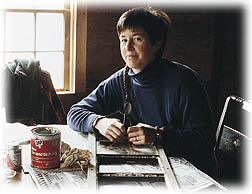 Not just for men
Not just for men
Alumnae build carpentry careers
Men aren't the only princetonians entering the trades. At least two alumnae swing a hammer for a living. Hilary Hamilton '85 (left) is a carpenter who specializes in historic preservation in Vermont, and Amy Escott '95 (below), who served as an apprentice for a building company, is now making custom furniture, cabinets, and trim in Warwick, Massachusetts.
Hamilton owns her own company, Hamilton Housewrights, which builds small projects such as new wainscot and kitchen cupboards. She also works on larger projects-restoring older homes and historic buildings-with other crews. In June she helped restore a steeple on an 1860s church in South Royalton, Vermont.
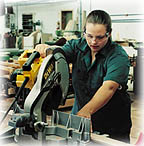 A comparative literature major at Princeton, Hamilton was a secretary
and taught environmental education before going to the North Bennet Street
School in Boston for its two-year program in preservation carpentry. Hamilton
prefers working on historic buildings, because she finds the old buildings
more aesthetically pleasing than the newer ones. She also believes that
"it's important to save a part of our cultural heritage."
A comparative literature major at Princeton, Hamilton was a secretary
and taught environmental education before going to the North Bennet Street
School in Boston for its two-year program in preservation carpentry. Hamilton
prefers working on historic buildings, because she finds the old buildings
more aesthetically pleasing than the newer ones. She also believes that
"it's important to save a part of our cultural heritage."
Hamilton is often the only woman on the job site, and two years ago became the only pregnant one. She worked through her seventh month of pregnancy, albeit at a slower pace, and on December 31, 1998, delivered Anyata May Hamilton. (Her tool belt became progressively more uncomfortable to wear as her belly swelled.) She finds that clients tend to treat her differently from the men on the crew. Homeowners, for example, sometimes invite Hamilton into their homes to use the facilities, but she usually demurs, choosing instead to use the outhouse.
Clients and coworkers at times treat Escott differently, too. To blend in, Escott, who majored in psychology, keeps her Princeton degree quiet. She fears the guys on the site might say, "'You went to Princeton? Why are you here hammering nails?' And I'm like 'Because this is what I want to do. This is what I think is challenging. This is what makes me happy.' "
Escott's father, an artist and art dealer who owns a custom framing shop in Summit, New Jersey, has also wondered why his daughter chose to work in the trades. Although he had hoped she would pursue a career in science, he has gotten used to the idea of his daughter doing manual labor. "He wanted something more for me," Escott says. "But now he's into it, because he understands how much like him I am."
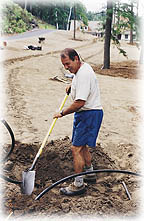 Digging ditches
Digging ditches
Leaving behind the corporate landscape
about 15 years ago, charles "chuck" merlini '66 left the corporate world, where he was earning $150,000 a year as a marketing manager for General Foods. "I'd probably be dead if I were still at General Foods," says Merlini, who spent 13 years at the company after earning a degree in religion from Princeton and an M.B.A. from Harvard. "I didn't see any reason to do a job that I wasn't getting a lot of satisfaction out of just for money."
After working with his wife's uncle as a financial planner for a condominium development, he switched careers again about 10 years ago to become a landscape laborer. His first year, at the age of 45, he earned $12,000. Today he's the foreman of a crew of 10 laborers. They install stone walls, patios, and irrigation systems and plant shrubbery and lawns for clients in the Berkshires.
When Merlini was considering the switch to landscaping, he and his wife, Leigh, a family-planning counselor, determined what they would need to earn collectively to "live comfortably." Fortunately, they had paid off their house, and their two children were grown, so they figured on $30,000. (A Princeton classmate of Merlini's told him, "Crap, my car insurance is more than that.") Merlini drives a 1995 GMC pickup truck, and he and Leigh live in a "modest farmhouse" on 62 acres in Richmond, Massachusetts.
Why the switch? In part, Merlini, who played varsity football in college, wanted to get in better shape. Working with his young crew has dropped Merlini from his office weight of 225 to 195. "I try to keep up with the 25-year-olds."
Since changing careers, Merlini has found that his quality of life has improved. "I've been more happy and content than I ever was when I was working in the corporate world," he says. Earning degrees from Princeton and Harvard "was like getting another medal," he says. "What I'm pursuing now is coming from something more fundamental inside me."
Occasionally, however, Merlini wonders if he should be putting his academic degrees to better use. "With this education, should I be doing something to improve the world more than I am?" His late father, he recalls, used to say, " 'If you don't get an education, you will be digging ditches.' And that's what I'm doing."
Kathryn Federici Greenwood is paw's staff writer.
A craftsman of wood and of words
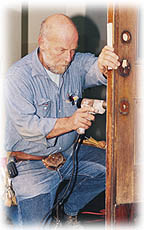 "I became a carpenter to support my poetry habit," says award-winning
poet Clemens Starck '59, who studied French literature at Princeton before
dropping out after his sophomore year. Starck eventually became a union
carpenter and found that the seasonal work gave him the opportunity to write
poetry-which he describes as "the focus of my existence." For
most of the past 35 years, he has been a carpenter and construction foreman,
working in California, Canada, and now Oregon. He has built furniture, custom
homes, libraries, hospitals, and bridges. Since 1987, he's worked as a carpenter
at Oregon State University in Corvallis.
"I became a carpenter to support my poetry habit," says award-winning
poet Clemens Starck '59, who studied French literature at Princeton before
dropping out after his sophomore year. Starck eventually became a union
carpenter and found that the seasonal work gave him the opportunity to write
poetry-which he describes as "the focus of my existence." For
most of the past 35 years, he has been a carpenter and construction foreman,
working in California, Canada, and now Oregon. He has built furniture, custom
homes, libraries, hospitals, and bridges. Since 1987, he's worked as a carpenter
at Oregon State University in Corvallis.
"I don't understand why more poets aren't carpenters," says Starck, who lives with his wife on a 43-acre farm outside Dallas, Oregon. After a time, he says, carpentry can become somewhat mechanical, leaving "a certain portion of your mind free." Starck has published two books of poems, Journeyman's Wages (Story Line Press, 1995) and Studying Russian on Company Time (Silverfish Review Press, 1999).
Remodeling the house (from Journeyman's Wages)
The next step was
to tear out the dormer
some half-assed handyman cobbled together,
ruining the lines of this old house,
and build it back again
proper.
Now every true apprentice knows
there are principles to reckon with, spirit
level and plumb bob; so,
I honor the man who taught me
the soul is a house
and you build it,
joining the wood,
driving the nails home.
GO TO the Table of Contents of the current issue
GO TO
PAW's home page